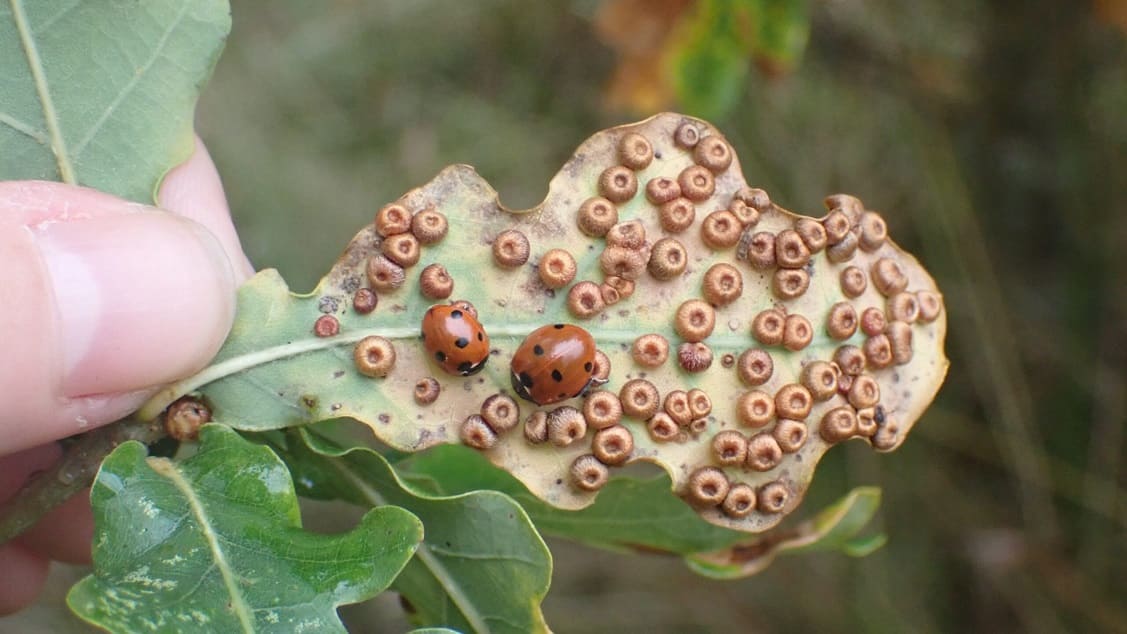I’ll never forget the first time I discovered what looked like perfect little ping-pong balls growing on an oak tree in my backyard. My initial thought was that someone had been playing a prank, somehow attaching these bizarre spherical objects to the leaves.
It wasn’t until I carefully cut one open—much to my fascination and slight horror—that I discovered a tiny white grub nestled inside what I later learned was a perfectly engineered home, created not by human hands, but by one of nature’s most incredible partnerships.
That day marked the beginning of my journey into the secret world of plant galls, and I suspect that by the end of this article, you’ll be just as captivated by these remarkable structures as I became.
What Exactly Are Plant Galls?
Plant galls are abnormal growths that appear on plants—think of them as nature’s version of custom-built apartment complexes.
These structures form when plants respond to the presence of foreign organisms by dramatically altering their normal growth patterns. The result? Completely new structures that the plant would never produce under normal circumstances.
Unlike plant diseases that damage or destroy tissue, galls represent something far more sophisticated: a hijacking of the plant’s own developmental machinery to create specialized homes and food sources for their inhabitants. It’s as if tiny architects have convinced the plant to build them penthouses complete with room service.
The term “gall” comes from the Latin word “galla,” meaning oak-apple, which gives you a hint about where these structures were first commonly observed. Scientists who study these fascinating formations are called cecidologists—a wonderfully specific field that combines botany, entomology, and developmental biology.
A Partnership Written in History
Humans have been fascinated by galls for millennia. Ancient civilizations noticed these strange growths and, with characteristic ingenuity, found ways to use them.
For over a thousand years, oak galls were the primary source of high-quality ink—the same iron gall ink used to write the Magna Carta and many other historical documents.
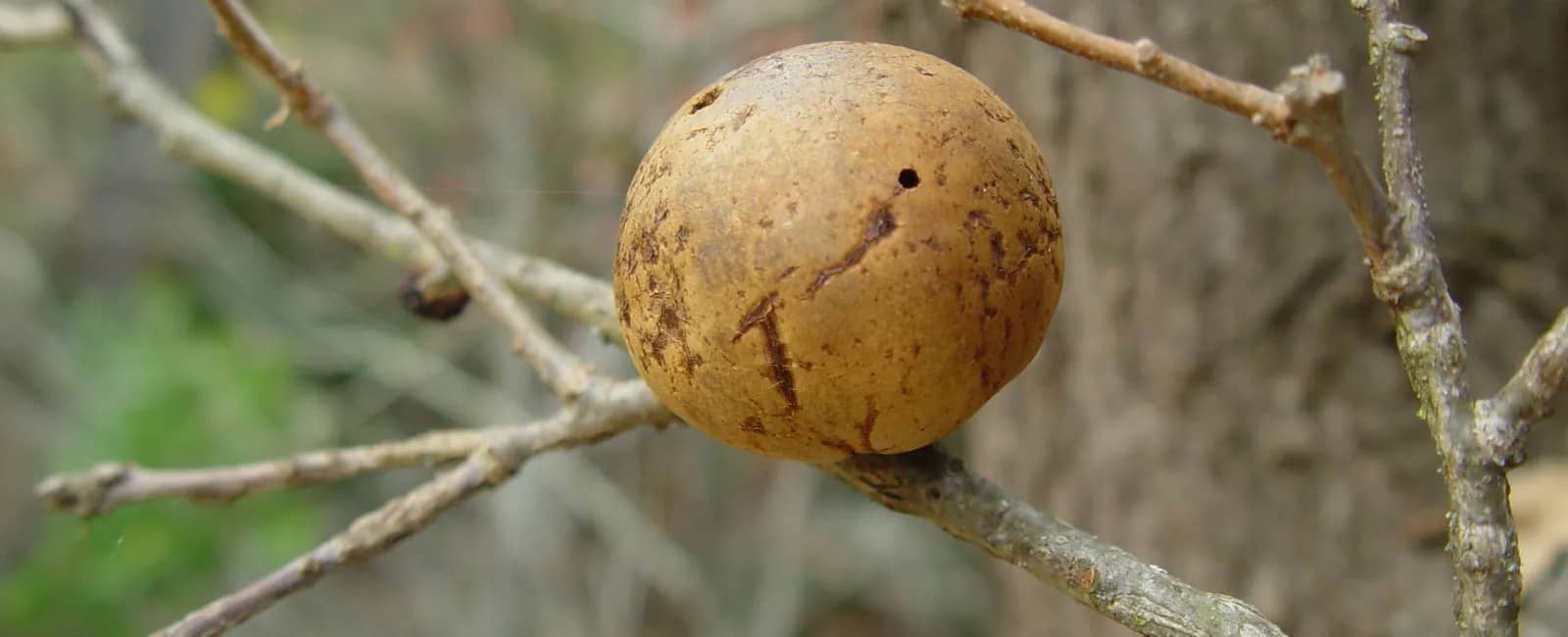
The high tannin content in these galls, originally evolved to protect the developing insect inside, proved perfect for creating permanent, fade-resistant writing materials.
Medieval traders valued certain galls so highly that they were among the most expensive exports from regions like northern Syria, where Aleppo galls fetched premium prices for their superior ink-making properties.
These same tannins that made excellent ink also proved valuable for tanning leather and creating dyes, making galls significant trade commodities long before anyone understood the biology behind their formation.
Even today, traditional craftspeople and historical document restorers still use gall-based inks, connecting us to centuries of human partnership with these remarkable structures.
The Amazing Architects: Who Creates These Living Sculptures?
The diversity of organisms capable of inducing galls is truly staggering. While insects are by far the most prolific gall-makers, they’re joined by an eclectic cast of characters that have each evolved their own approaches to plant manipulation.
Insects represent the master class of gall architects. Gall wasps, particularly those in the family Cynipidae, create some of the most complex and beautiful structures you’ll encounter, especially on oak trees.
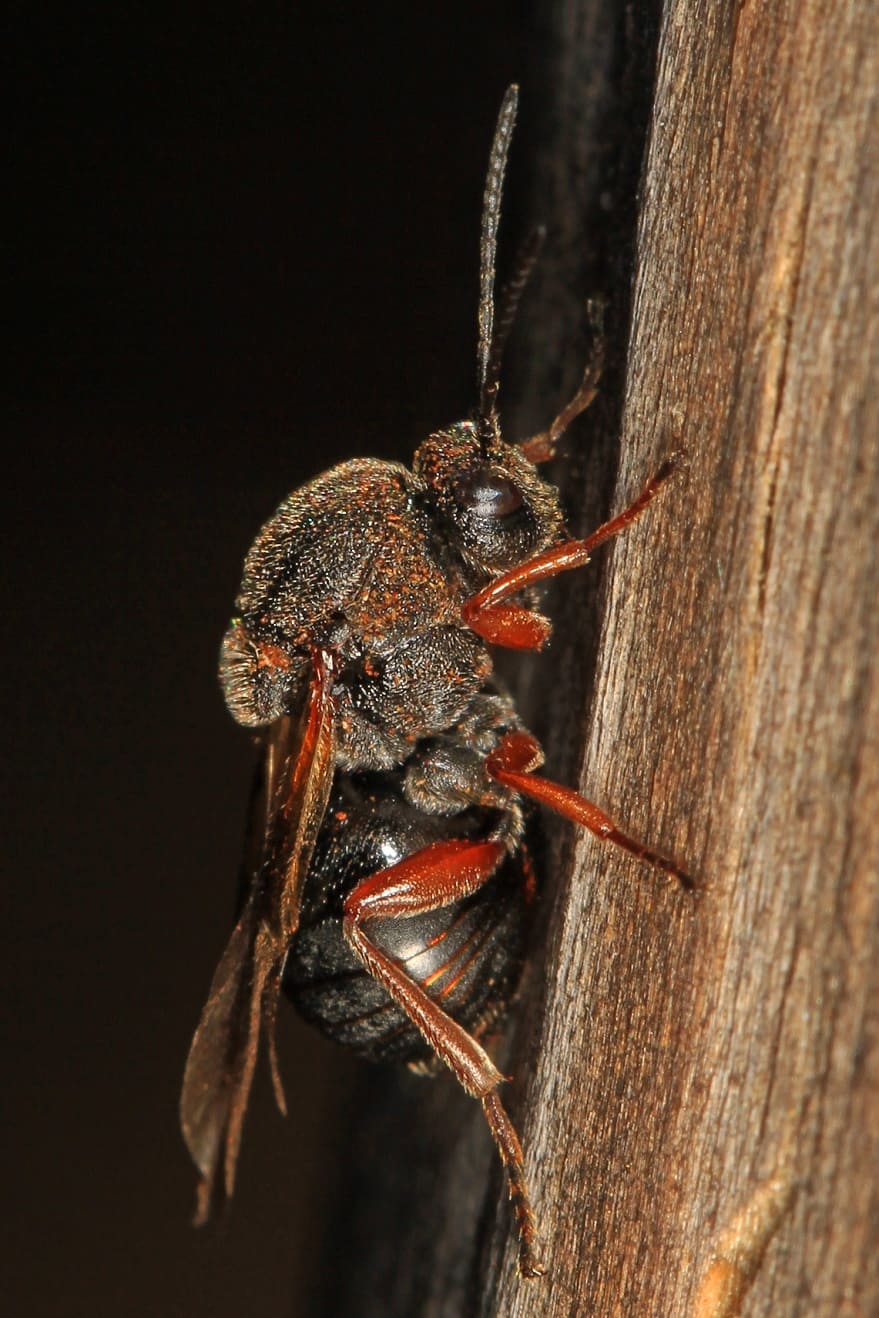
A single mature oak can host over 70 different types of galls, each created by a different species of wasp, midge, or other insect. This incredible diversity means that one tree can serve as a living museum of biological architecture.
Gall midges deserve special mention as they’re responsible for roughly 70% of all insect galls in many regions. These tiny flies create structures ranging from simple leaf rolls to elaborate, multi-chambered complexes.
What makes their story particularly fascinating is that many species have incredibly specific relationships with their host plants—so specific that finding a new gall often means discovering a new species of midge.
But insects aren’t alone in this endeavor. Microscopic mites create the fuzzy, hair-like structures called erineum galls that you might notice as patches of abnormal fuzz on leaves.
Bacteria like Agrobacterium tumefaciens create the infamous crown galls—rough, tumor-like growths that lack the organized beauty of insect galls but demonstrate the same fundamental principle of genetic manipulation across species boundaries.
Even other plants get in on the action. Mistletoe creates woody galls on its host branches, and over time, these can become quite substantial. I’ve seen old oak trees bearing mistletoe galls that look like massive wooden burls, testament to decades-old partnerships between parasite and host.
The Science Behind the Magic: How Galls Form
Understanding how galls form is like watching a master class in biological engineering. The process begins with what scientists call “effector molecules”—specialized chemicals that serve as molecular messengers between species.
When a gall-making organism encounters a suitable plant, it doesn’t simply start feeding randomly. Instead, it delivers a precise cocktail of these effector molecules that essentially reprogram the plant’s genetic instructions.
Think of it as installing new software that changes how the plant grows, but the process is far more sophisticated than any human programming. The plant’s cells, receiving these foreign chemical signals, begin dividing and differentiating in entirely new ways.
They create what scientists call “nutritive tissue”—specialized cells packed with sugars, proteins, and other nutrients that serve as a living pantry for their unexpected guest.
What makes this process particularly remarkable is its precision. The gall-maker doesn’t just trigger random growth; it orchestrates the development of specific tissue types in specific locations.
The outer layers of many galls become tough and protective, often containing high concentrations of tannins and other defensive compounds. Meanwhile, the inner chambers remain soft and nutritionally rich, creating perfect nurseries for developing larvae.
This nutritive tissue is unlike anything the plant normally produces. Under microscopic examination, these cells appear almost hyperactive—packed with organelles, featuring fragmented vacuoles and enlarged nuclei, all indicators of intense metabolic activity.
The plant is essentially creating a specialized organ it never evolved to make, all under the chemical direction of its tiny tenant.
The timing of this process is crucial. Most gall formation occurs during periods of rapid plant growth, particularly in spring when cells are already actively dividing. This is why you’ll often notice new galls appearing on fresh growth rather than mature plant parts.
The gall-makers have evolved to take advantage of the plant’s natural growth rhythms, inserting their chemical instructions at just the right moment.
Seasonal Rhythms and Remarkable Life Cycles
One of the most fascinating aspects of gall biology is how these organisms have synchronized their lives with the rhythms of their host plants.
Spring is prime time for gall formation, when plants are rapidly producing new growth and cells are actively dividing. This is when you’ll see the initial swellings and distortions that mark the beginning of gall development.
Many gall-makers have evolved life cycles of extraordinary complexity. Some gall wasps alternate between two completely different generations that create entirely different galls.
The spring generation might create small, inconspicuous galls on leaf buds, while the summer generation produces large, showy structures on mature leaves. For years, scientists thought these were different species entirely, until patient observation revealed the connection.
Summer brings the peak of gall diversity, when these structures reach their full size and complexity. This is the best time for gall hunting, as structures are most visible and often at their most colorful. Many galls change color as they mature—starting green and progressing through yellows, reds, and browns as the season advances.
Fall offers its own rewards for gall observers. Many structures become more visible as leaves drop, revealing stem and twig galls that were hidden by foliage. This is also when many galls release their inhabitants, creating emergence holes that tell the story of successful development.
Winter galls, like the familiar goldenrod ball galls, stand out dramatically against the dormant landscape and often contain overwintering larvae that serve as important food sources for birds and small mammals.
👉 Here’s How to Grow Goldenrod: Benefits, Types & Care Tips for Your Garden
A Gallery of Common Galls and How to Recognize Them
Learning to identify common galls is like developing a new language for reading the landscape. Each type has its own distinctive characteristics that, once learned, make identification straightforward. Let me take you on a tour of the most frequently encountered galls, organized by their host plants.
The Oak Gallery: Nature’s Premier Gall Collection
Oak trees are the undisputed champions of gall diversity, hosting more types than any other plant group. If you learn to recognize oak galls, you’ll have mastered a significant portion of the gall world.
Oak Apple Galls are perhaps the most recognizable, appearing as tan to brown spheres roughly the size of ping-pong balls attached to oak leaves or twigs. When fresh, they feel surprisingly light due to their spongy internal structure.
Cut one open and you’ll find a hard central chamber containing a single wasp larva, surrounded by layers of increasingly soft tissue.

Oak Marble Galls live up to their name, appearing as perfect brown spheres about the size of marbles attached to twigs and branches.
These have a much denser, harder texture than oak apples and were historically prized for their high tannin content in ink-making. Look for the small dimples that often decorate their surface—these are the telltale signs of marble galls.

Oak Bullet Galls create distinctive elongated swellings on twigs that look remarkably like ammunition, hence their name. These brown, woody galls often occur in clusters and can persist on branches for several years after the wasps have emerged.
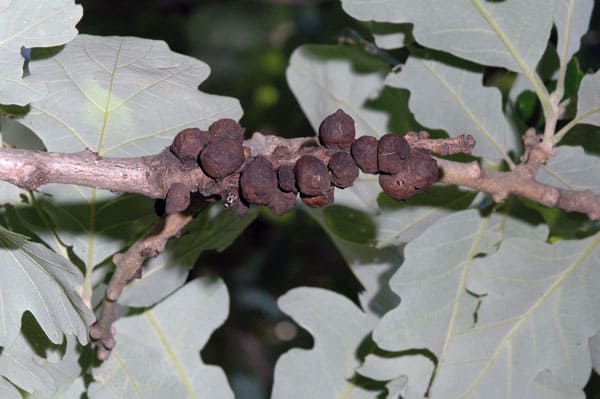
Gouty Oak Galls and Horned Oak Galls represent some of the more problematic oak galls. These create large, irregular swellings on twigs and branches that can actually girdle and kill the affected wood. Horned oak galls develop distinctive spike-like projections as they mature, giving them an almost medieval appearance.
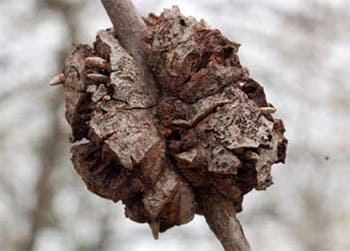
Oak Hedgehog Galls are among the most charming, appearing as small spheres covered in soft spines that make them look like tiny sea urchins. Usually found on the undersides of white oak leaves, they often display beautiful colors ranging from green to deep red.
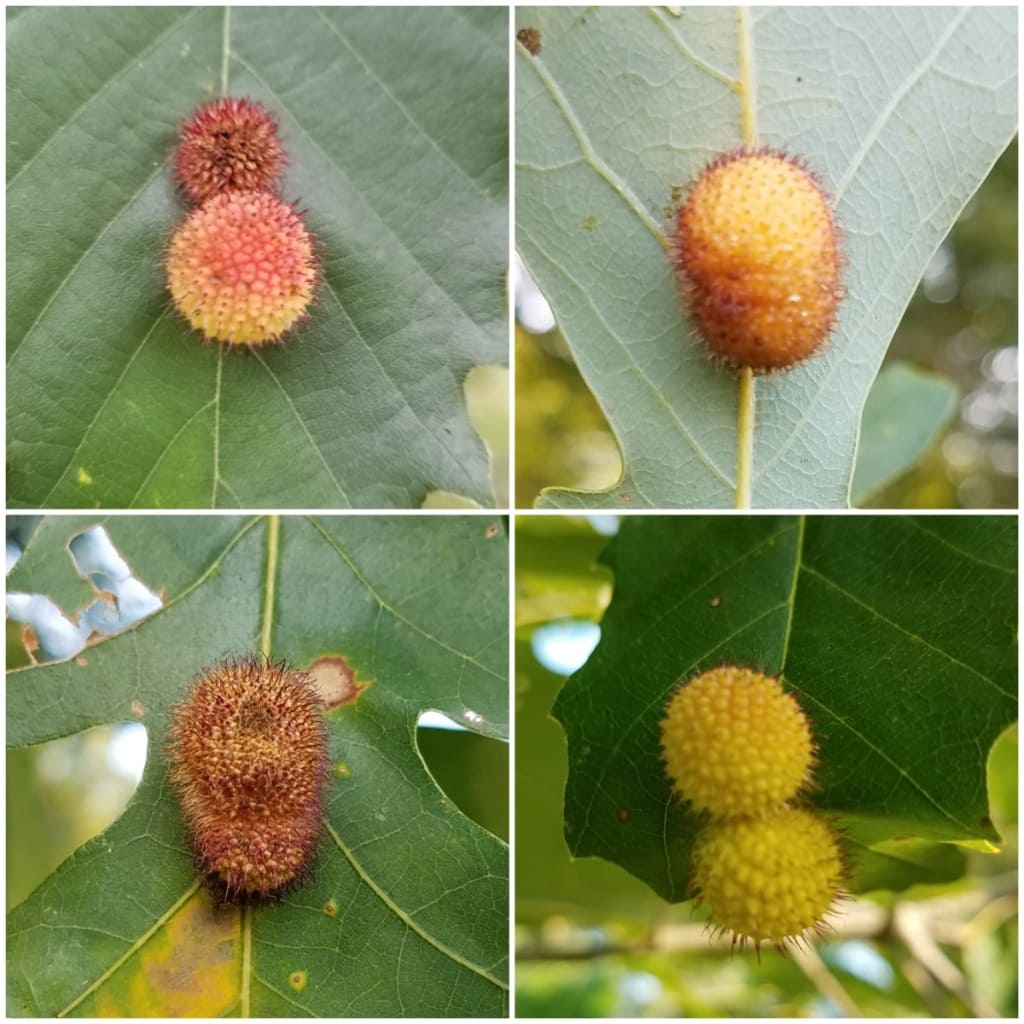
Jumping Oak Galls create one of nature’s most entertaining spectacles. These small, seed-like galls actually jump and roll around when they fall from the tree, propelled by the active larva inside. The movement helps them work into soil crevices where they’ll complete development.
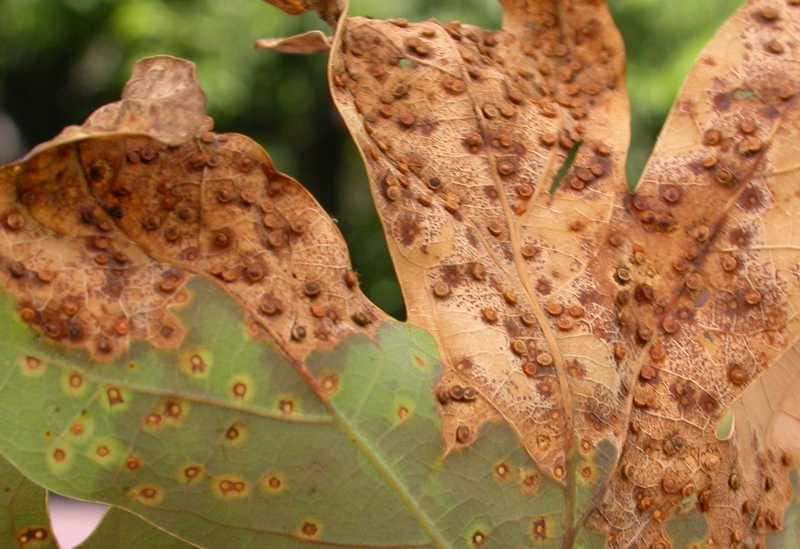
Oak Knopper Galls transform acorns into bizarre, sculptural forms that look more like abstract art than anything biological. These galls completely envelop developing acorns, creating ridged, often colorful structures that can be green, yellow, or reddish-brown.
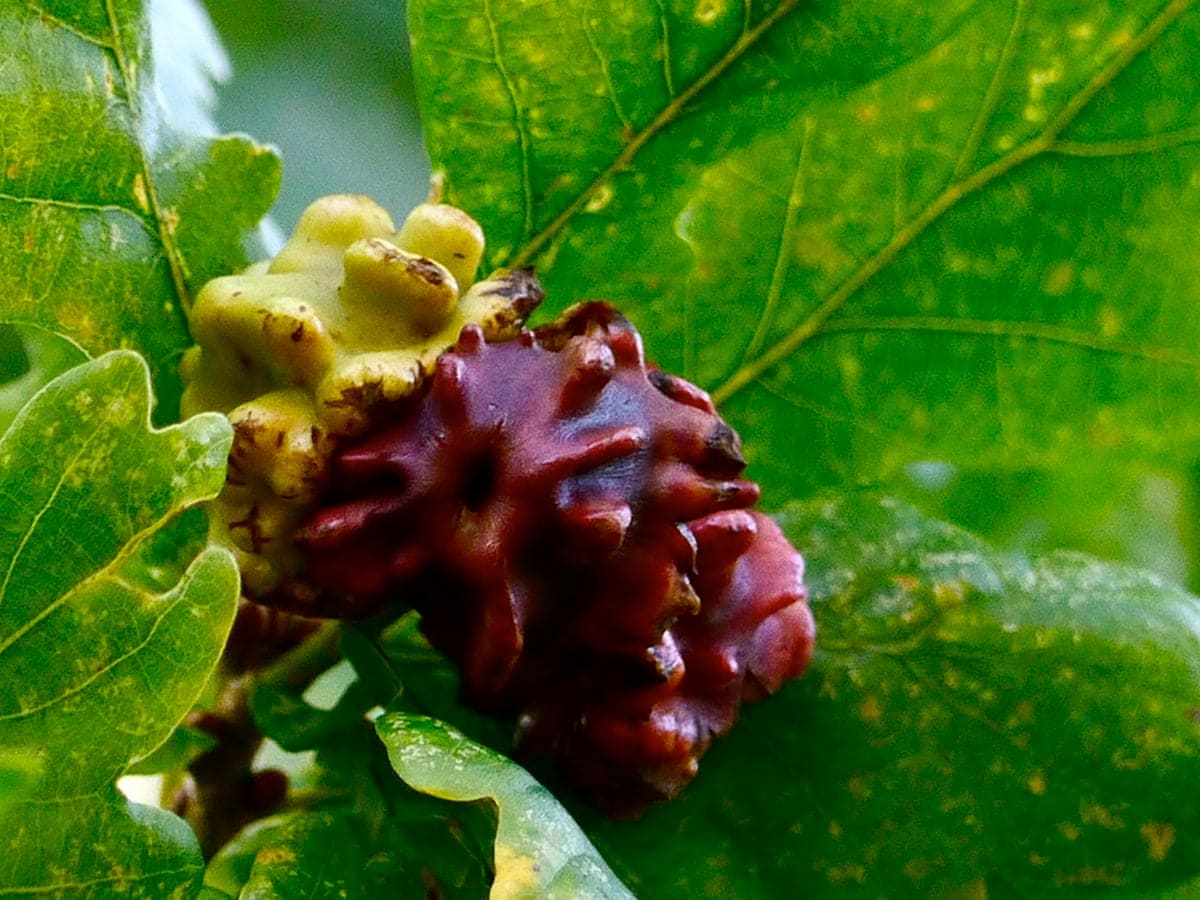
Maple Marvels: Mite-Made Masterpieces
Maple trees showcase the artistry of mite engineering, producing some of the most colorful and dynamic galls you’ll encounter.
Maple Bladder Galls represent perhaps the most spectacular color show in the gall world. These small bumps on maple leaves start green but progress through an amazing transformation—first pink, then bright red, deep burgundy, and finally black.
They’re created by tiny eriophyid mites and are completely harmless to the tree, adding an almost ornamental quality to affected leaves.
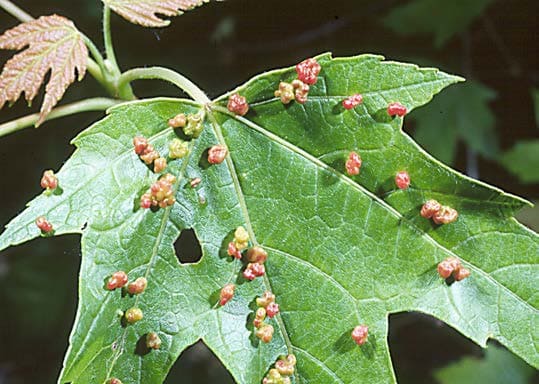
Maple Spindle Galls create slender, finger-like projections rising from the upper surfaces of sugar maple leaves. These pale green to pinkish structures can reach nearly an inch in length and often occur in clusters, giving affected leaves a distinctly alien appearance. Like bladder galls, they’re the work of specialized mites.

Spruce Specialties: Conifer Creations
Spruce Pineapple Galls are among my favorites for their whimsical appearance. They look exactly like tiny pineapples decorating the tips of spruce branches, complete with scale-like segments. Created by adelgids (tiny aphid-like insects), each segment eventually opens to release the insects, making the galls appear to bloom in reverse.
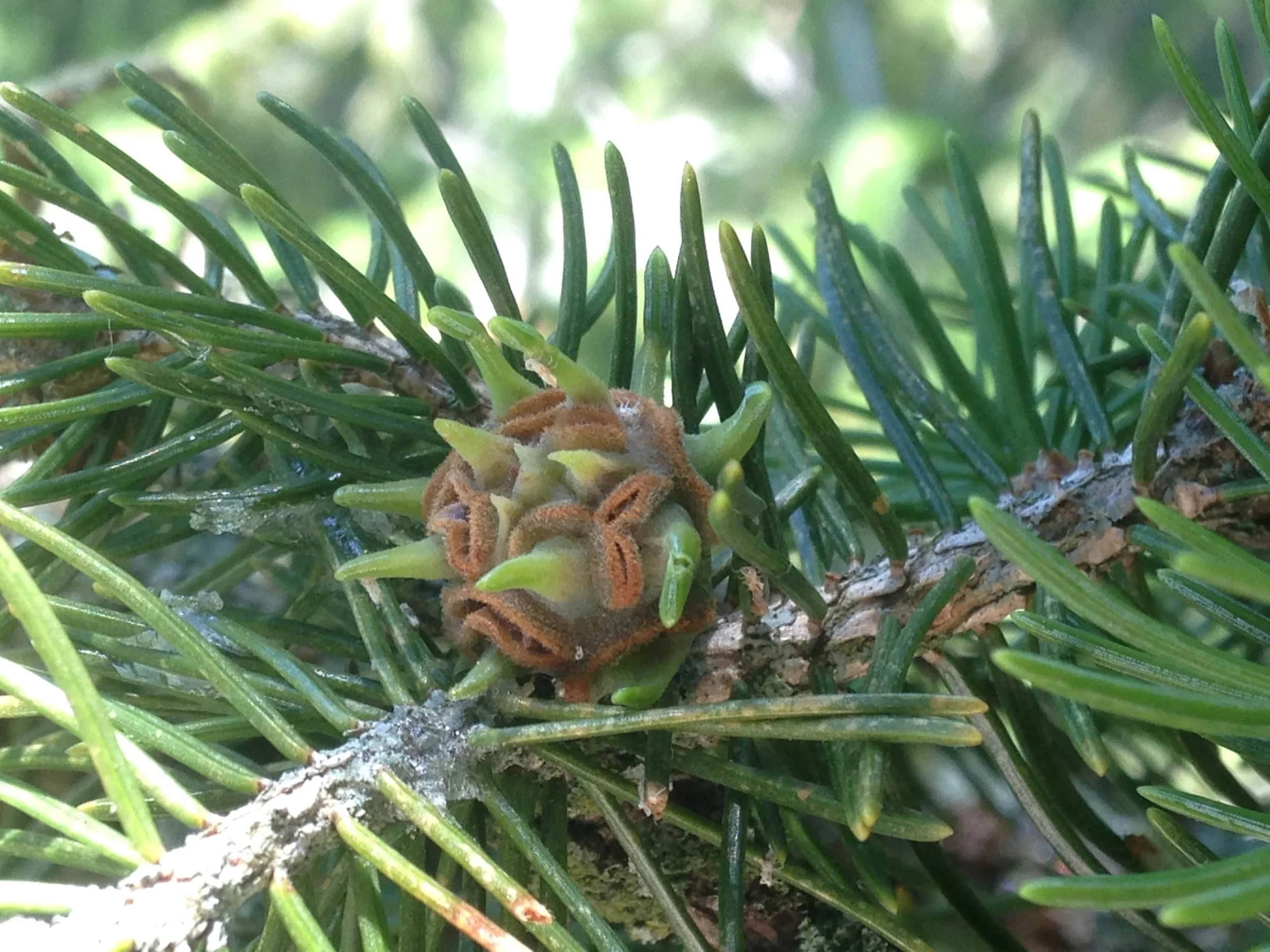
Cooley Spruce Galls are larger and more cone-shaped than pineapple galls, typically measuring 2-4 inches in length. These galls start green-purple and turn brown as they mature, occurring at the tips of new growth on Colorado blue spruce and white spruce.
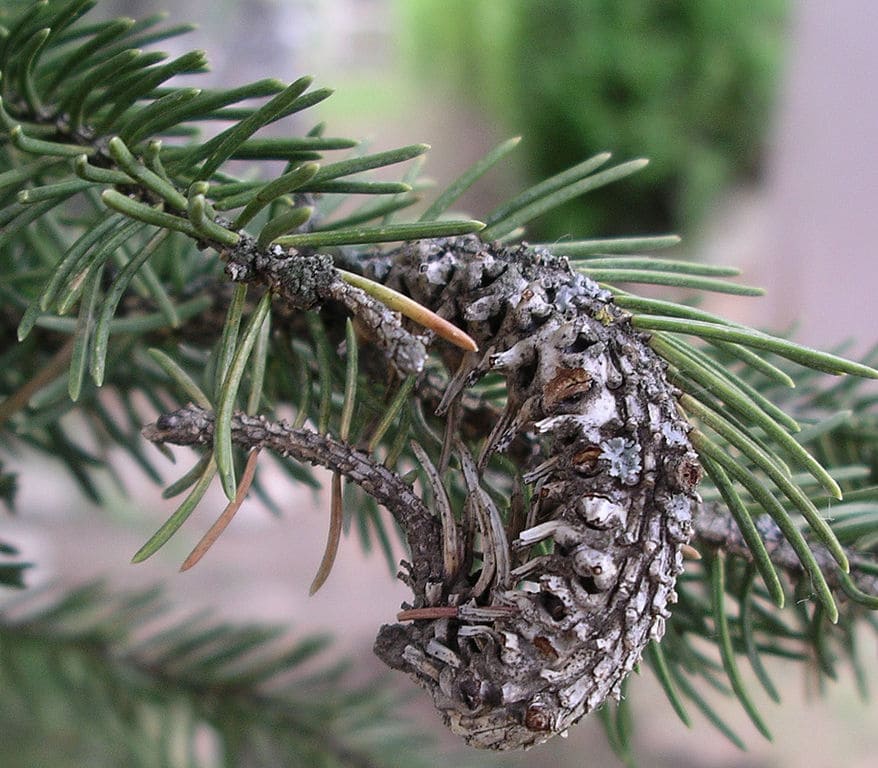
Ash and Other Tree Treasures
Ash Flower Galls transform the male flowers of ash trees into dense, brushy masses that persist long after normal flowering ends. Created by tiny mites, these galls start green when the mites are active and turn brownish-black after the mites leave, sometimes persisting on trees for several years.
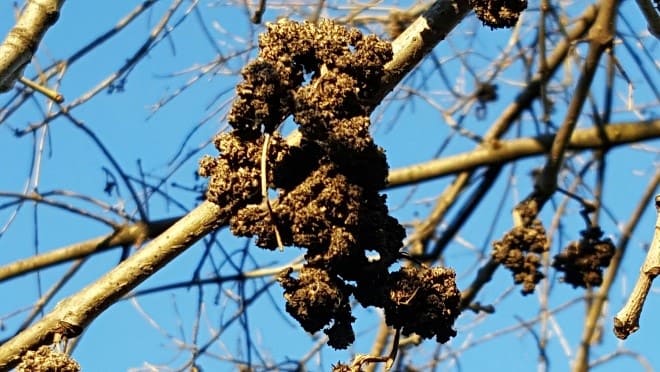
Hackberry Nipple Galls create distinctive bumps on the undersides of hackberry leaves, earning their name from their breast-like appearance. These galls, caused by psyllids (jumping plant lice), can be so numerous that they completely cover leaf surfaces, turning the undersides into landscapes of tiny green and purple protrusions.
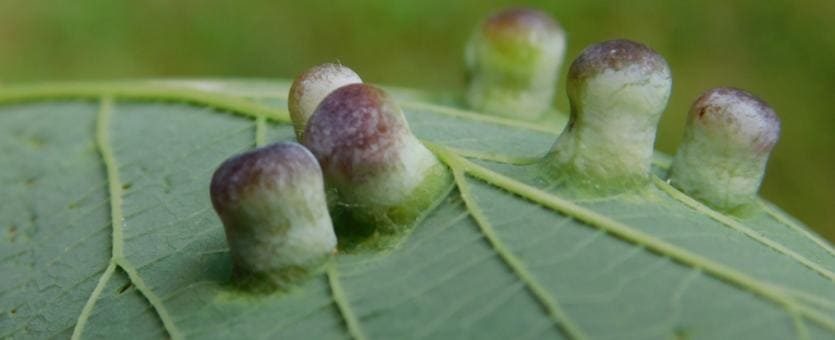
Elm Finger Galls produce slender, curved projections from elm leaves that look remarkably like tiny fingers beckoning from the foliage. These structures, caused by aphids, can grow quite long and often have a distinctive curved shape.
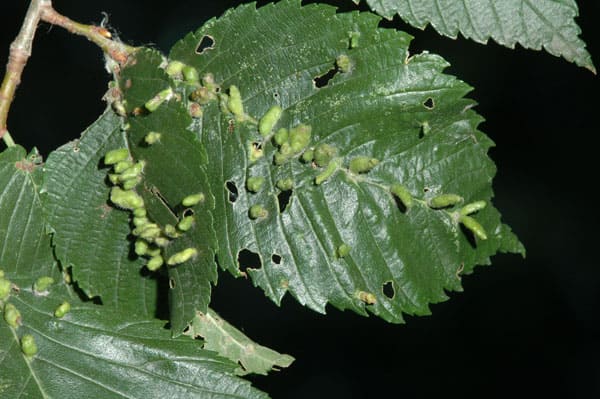
Lime Nail Galls create bright red, cone-shaped projections on lime tree leaves that look exactly like tiny nails driven through the leaf surface. Each gall houses numerous mites and can contain hundreds of larvae by season’s end.
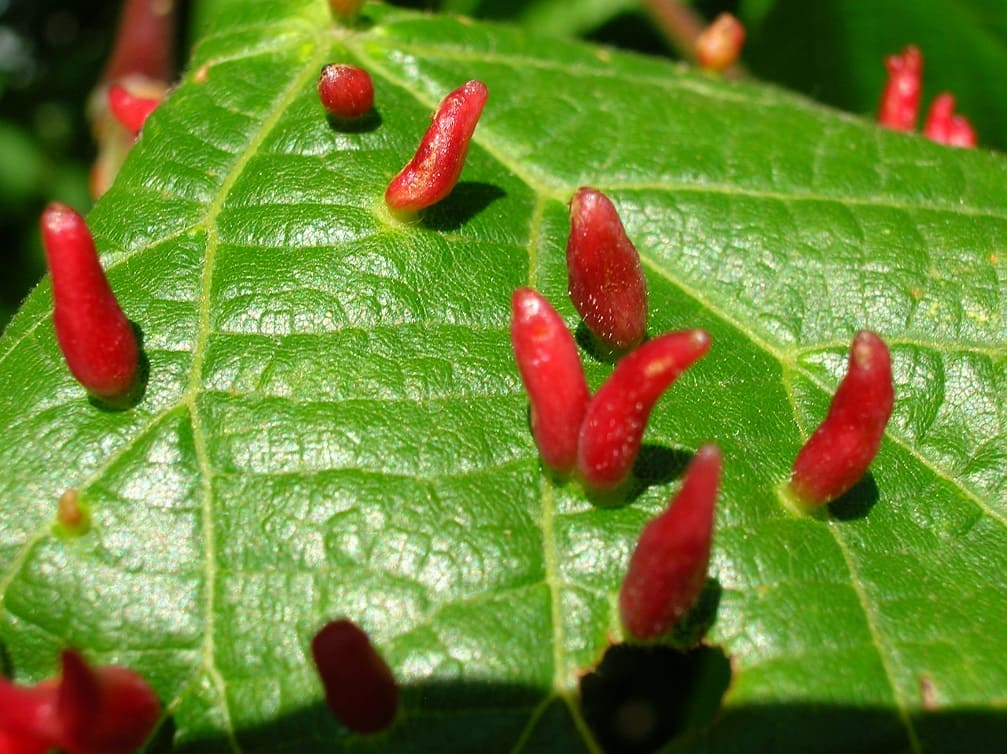
👉 Read The Ultimate Guide to Growing Finger Limes: Tips for Cultivation
Unique Specialty Galls
Rose Bedeguar Galls, also known as Robin’s Pincushion, create some of the most distinctive and beautiful galls in the plant kingdom. These fuzzy, moss-like growths appear on wild roses and can reach the size of tennis balls.
Covered in dense, colorful filaments that can be green, red, or golden, they house multiple wasp larvae in separate chambers within the structure.
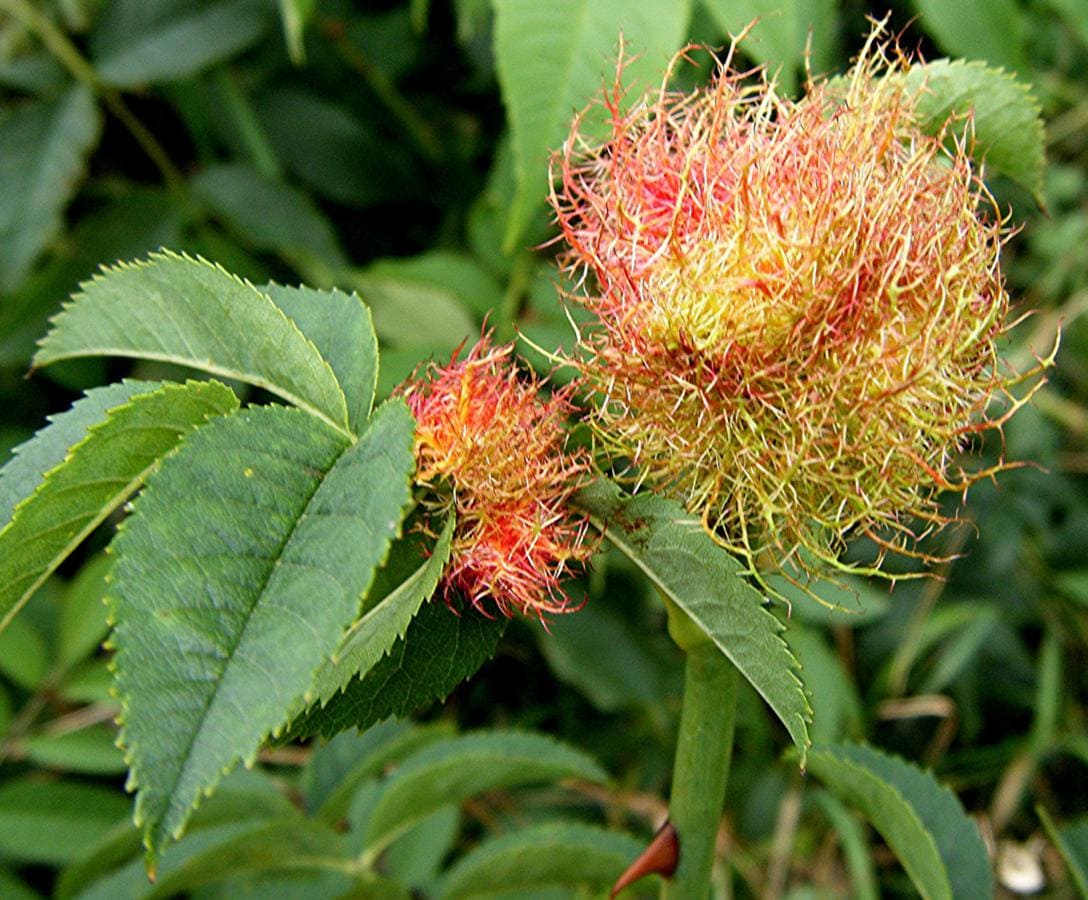
Goldenrod Ball Galls become most noticeable in winter when their spherical swellings stand out against dormant stems. Created by fruit flies, these galls often contain plump larvae that overwinter inside, providing crucial protein sources for birds during harsh months. They’re so perfectly spherical they look almost artificial.
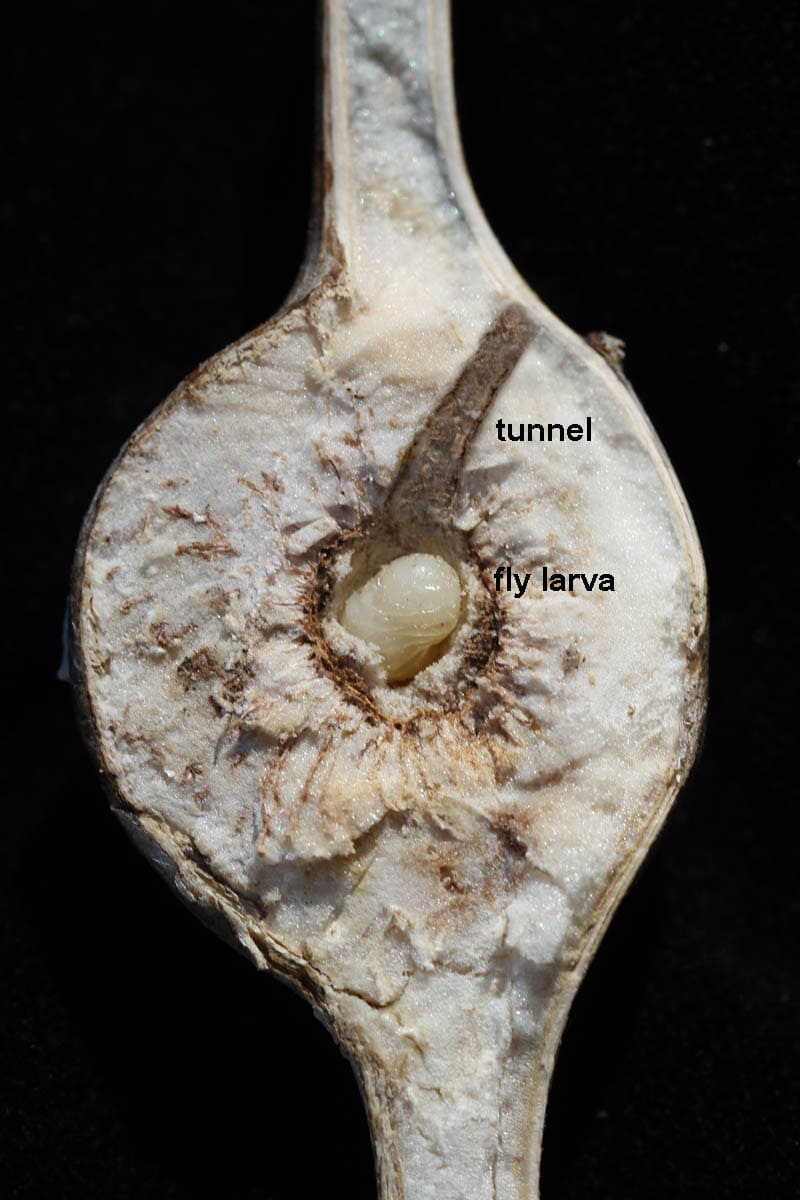
Witch Hazel Cone Galls appear as pointed, cone-shaped structures on witch hazel leaves, created by aphids that have a complex life cycle involving both witch hazel and birch trees. These galls can be quite numerous and add an interesting texture to affected foliage.
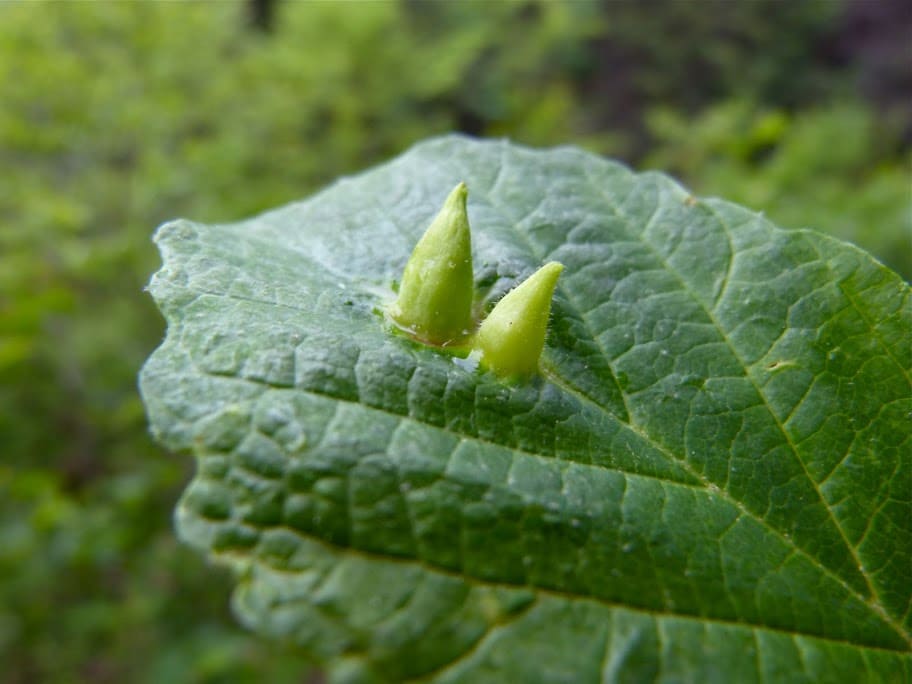
Poplar Petiole Galls create dramatic swellings on the leaf stalks of cottonwood and aspen trees. These galls, caused by aphids, can become quite large and eventually turn black as they mature, sometimes causing affected leaves to droop under their weight.

Cedar-Apple Rust Galls represent fungal artistry at its finest. These brain-like, brownish galls appear on juniper trees and, during wet spring weather, produce spectacular orange, gelatinous “horns” that extend from the gall surface like alien tentacles. These horns release spores that must reach apple trees to complete the fungus’s life cycle.
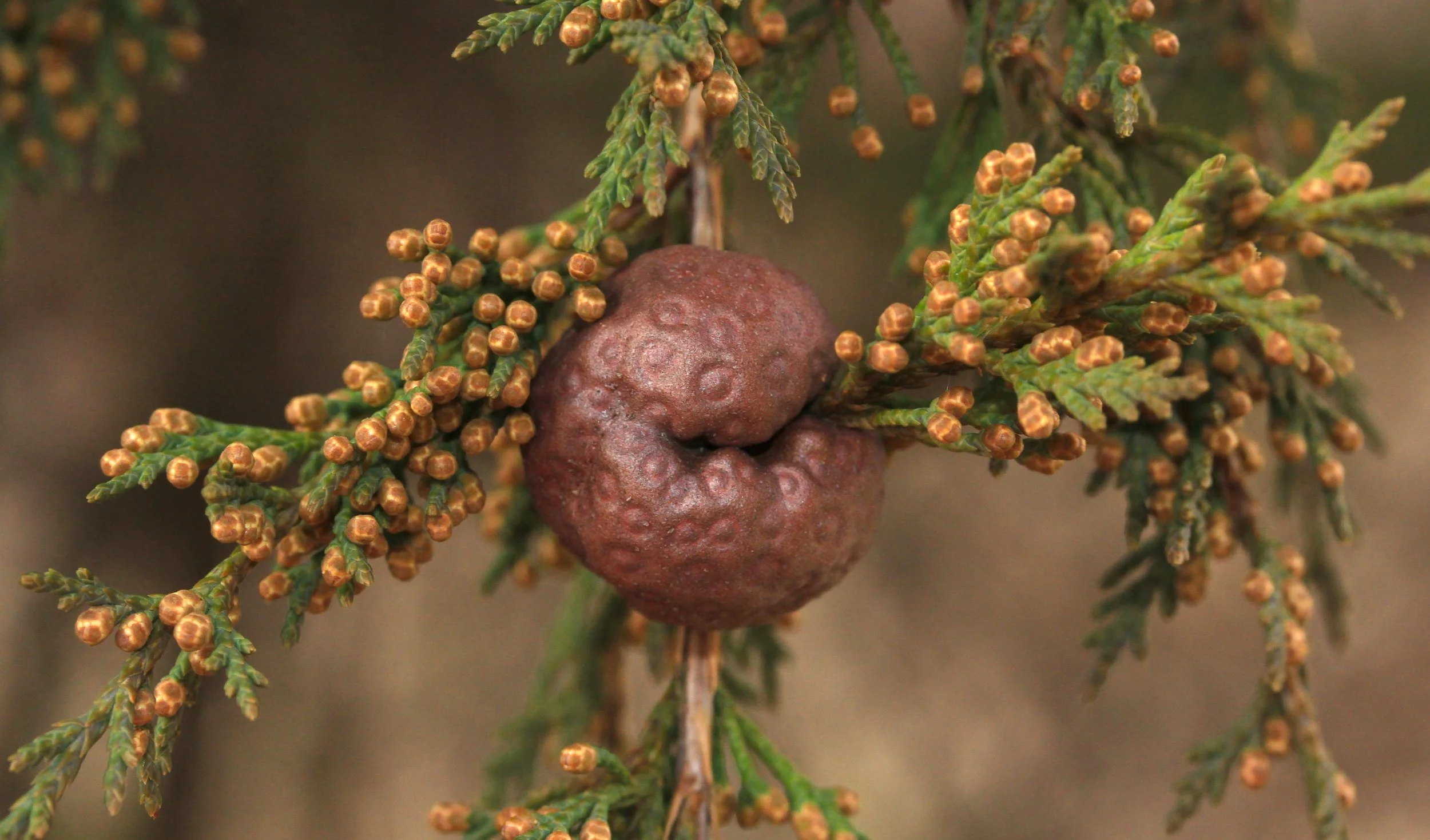
The Crown Gall Exception
Crown Galls present a different aesthetic entirely from all the precisely organized insect and mite galls. These bacterial creations appear as rough, irregular, tumor-like growths at the base of plants, lacking the organized beauty of insect galls but demonstrating raw biological power.
While they can be more problematic than insect galls, they’re rarely fatal to established plants and serve as important reminders that not all galls are created by insects.
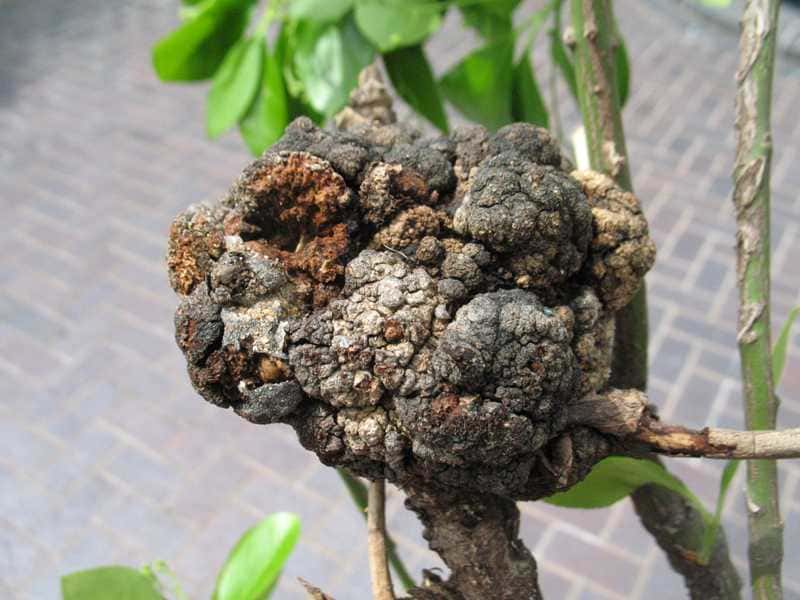
Each of these galls tells its own story of biological partnership, architectural innovation, and evolutionary adaptation. Learning to recognize them transforms any walk through gardens, parks, or natural areas into an exploration of nature’s most creative collaborations.
The Hidden Communities: Galls as Miniature Ecosystems
What truly amazes me about galls is that they often support entire communities of organisms beyond their original architects. Scientists have discovered that many galls become miniature ecosystems supporting what they poetically call “inquilines”—uninvited guests that move into galls rent-free.
These inquiline species have evolved to exploit the safe, nutritious environment that the original gall-maker created. Some are benign tenants that simply share space, while others may outcompete or even consume the original inhabitant. The result is a complex web of relationships playing out within structures sometimes smaller than a marble.
Then there are the parasitoids—specialized wasps that lay their eggs inside gall-making larvae. These tiny assassins can detect the presence of their victims inside galls and use specialized egg-laying equipment to penetrate the gall wall and reach their target.
It’s an evolutionary arms race in miniature, with gall-makers developing thicker walls and defensive compounds while parasitoids evolve longer, more precise ovipositors and chemical detection systems.
Birds and mammals add another layer to these communities. Woodpeckers become expert gall surgeons, precisely extracting larvae from their protective chambers. Squirrels and mice harvest overwintering galls as protein-rich snacks.
👉 Here’s How to Keep Squirrels Out of Your Garden: Effective Strategies for Gardeners
Even ants may be drawn to galls that produce sweet secretions, creating mutually beneficial relationships where the ants provide protection in exchange for food.
Separating Myth from Reality: What Galls Mean for Plant Health
One of the most persistent misconceptions about galls is that they represent serious plant diseases. In reality, most galls are more like having houseguests than suffering from an illness.
The vast majority of gall-making organisms have evolved what ecologists call “enlightened parasitism”—they benefit from their host without significantly harming it, because dead plants make poor long-term homes.
This doesn’t mean all galls are completely harmless. Crown galls, those rough bacterial growths, can occasionally girdle stems or major roots, potentially causing problems for young or already stressed plants. Heavy infestations of any gall type on small plants can sometimes affect growth, much like any stress factor.
However, the key is perspective and proportion. A few leaf galls on a mature oak tree represent a tiny fraction of the tree’s total photosynthetic capacity. The tree continues its normal functions while providing room and board for its tiny tenants. It’s a biological compromise that has worked for millions of years.
The best approach is informed observation rather than panic. Monitor galled plants for signs of stress like wilting, yellowing, or reduced growth, but remember that the galls themselves are rarely the primary cause of such problems.
👉 Discover Why Are My Cucumber Leaves Turning Yellow? Top Causes & Solutions
More often, environmental stresses like drought, poor soil, or other factors make plants more susceptible to gall formation in the first place.
When and How to Take Action
Most of the time, the best management strategy for galls combines benign neglect with curious observation. However, there are situations where intervention makes sense, and understanding when and how to act can prevent unnecessary worry while addressing legitimate concerns.
Timing is everything in gall management. Early intervention, before galls fully develop, is most effective when action is truly necessary. This typically means acting in spring when you first notice the initial swellings or distortions that signal gall formation beginning.
For leaf galls on established plants, simple removal of affected leaves or branches often suffices when aesthetic concerns outweigh ecological interest. This is particularly relevant in formal landscape settings where the unusual appearance of galls might detract from desired visual effects.
👉 Explore 13 Fiddle Leaf Fig Problems and How to Solve Them With Easy Fixes
Crown galls require more serious consideration due to their potential to affect plant structure. Removing affected tissue and improving soil drainage can help prevent their spread, though complete elimination is often impossible once they’re established.
Prevention remains the most effective long-term strategy. Maintaining plant health through proper site selection, appropriate watering, and balanced nutrition creates conditions that favor plant resistance to gall formation.
Stressed plants are generally more susceptible to gall-making organisms, so addressing underlying health issues often reduces gall problems naturally.
Creating diverse garden ecosystems that support natural predators and parasitoids also helps maintain biological balance. Birds, beneficial insects, and other organisms that feed on gall-makers or their enemies contribute to natural population control without requiring human intervention.
The Bigger Picture: Why Galls Matter in Our Changing World
Beyond their intrinsic fascination, galls play important roles in ecosystems that we’re only beginning to fully appreciate. They represent one of nature’s most sophisticated examples of species interaction, demonstrating how organisms can manipulate each other’s biology across vast evolutionary distances.
From a scientific perspective, galls serve as natural laboratories for studying fundamental biological processes. The mechanisms that gall-makers use to reprogram plant development are teaching us about hormone signaling, cellular differentiation, and gene expression.
This knowledge has applications ranging from agricultural biotechnology to understanding human cancer biology.
Ecologically, galls support complex food webs that extend far beyond their immediate participants. They provide overwintering habitat for beneficial insects, serve as food sources for birds and mammals, and create microhabitats that support diverse communities of smaller organisms.
In an era of declining insect populations and habitat loss, these miniature ecosystems take on increased importance.
Climate change adds another dimension to gall ecology. As weather patterns shift and species ranges change, the intricate timing relationships between gall-makers and their hosts may be disrupted.
Some gall-making species might benefit from warmer temperatures and longer growing seasons, while others could suffer from phenological mismatches with their host plants.
Understanding these relationships becomes increasingly important as we work to maintain biodiversity in changing environments. Galls remind us that conservation isn’t just about protecting individual species, but about preserving the complex web of interactions that make ecosystems function.
Practical Gall Watching: Becoming a Backyard Cecidologist
Once you start noticing galls, you’ll discover they’re everywhere, and developing skills as a gall observer can transform ordinary walks into fascinating explorations. The key is learning to see familiar plants with new eyes, looking for the subtle signs that indicate nature’s architectural experiments are underway.
Start with oak trees if you have them available, as they host the greatest diversity of gall types. Learn to recognize the major categories—spherical apple galls, flattened button galls, spiny hedgehog galls, and stem swellings—then gradually develop awareness of the variations within each group.
Timing your observations enhances the experience significantly. Early spring offers opportunities to see gall formation beginning, summer provides peak diversity and color, fall reveals structures hidden by leaves, and winter showcases persistent galls against dormant landscapes.
Keep a simple journal of your discoveries, noting dates, locations, host plants, and gall characteristics. Photography helps with later identification and creates a record of seasonal changes. Many galls change dramatically as they mature, and documenting these transformations reveals the dynamic nature of these structures.
Don’t hesitate to carefully examine galls more closely. Most can be safely handled, and cutting open mature galls often reveals fascinating internal architecture.
Look for the specialized chambers, different tissue types, and sometimes the inhabitants themselves. Just remember to use clean tools and avoid disturbing galls that clearly contain developing organisms.
Connect with others who share this interest through local naturalist groups, online communities, or citizen science projects. Gall enthusiasts are typically generous with their knowledge and eager to share discoveries. Many regions have experts who can help with identification of unusual finds.
Looking Forward: The Future of Gall Science
As we advance deeper into the 21st century, our understanding of galls continues to evolve rapidly. New molecular techniques are revealing the sophisticated mechanisms by which gall-makers manipulate their hosts, often involving the transfer of genetic material between species—a phenomenon that challenges traditional concepts of biological boundaries.
Recent discoveries suggest that some gall-making insects may actually carry bacterial symbionts that produce the plant hormones necessary for gall formation. This adds another layer of complexity to what we already knew was an intricate biological process, suggesting that galls might result from three-way partnerships between insects, bacteria, and plants.
These findings have implications beyond pure science. Understanding how organisms naturally manipulate plant development could lead to new approaches in agriculture, horticulture, and biotechnology. The precision with which gall-makers control plant growth might inspire new methods for crop improvement or sustainable pest management.
As environmental challenges mount, galls also serve as indicators of ecosystem health. Changes in gall diversity or abundance can reflect broader environmental shifts, making these structures valuable tools for monitoring ecosystem conditions over time.
Embracing Wonder in Unexpected Places
After years of gall watching, I’ve come to see these structures as reminders that our world is far more interconnected and surprising than we often realize. Every gall represents a successful negotiation between vastly different forms of life, resulting in structures that neither organism could create alone.
In our human-dominated landscapes, galls offer glimpses of the wild creativity that emerges when nature is allowed to express its full potential. They remind us that even in our most managed environments—suburban yards, city parks, agricultural fields—biological innovation continues to unfold in ways that can surprise and delight us.
The next time you’re walking through your garden or a local park, take a moment to look more closely at the plants around you. Those odd bumps, colorful spheres, or unusual growths aren’t plant defects—they’re windows into one of nature’s most sophisticated partnerships.
They’re proof that in biology, as in the best human collaborations, the most remarkable achievements often emerge when different kinds of expertise combine in unexpected ways.
Perhaps most importantly, galls teach us about the value of looking closely at what we might otherwise dismiss as imperfections. In a world that often emphasizes the normal and standardized, these biological anomalies celebrate diversity, creativity, and the endless capacity for life to find new ways of thriving together.
Who knows? You might just find yourself becoming a cecidologist without even realizing it—and discovering that some of nature’s most beautiful solutions have been hiding in plain sight all along.
